Southern California Contest Club
CQ WW DX SSB: October 25-26 ARRL Sweepstakes CW: November 1-3 NA Sprint SSB: November 23
CQ WW DX SSB: October 25-26 ARRL Sweepstakes CW: November 1-3 NA Sprint SSB: November 23
Past Feature Stories (Newest to Oldest)
The SO9Q Contest Station - Piotr Sanecznik SP9QMP
December 2014
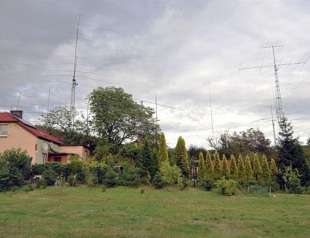 Our club was founded in 1994, with assigned call SP9YDX. Responsible operators at that time were Jan SP9EIJ, Alek SP9NLK i Roman SP9FOW. Right now after a few
changes the list of responsible operators is as follows: Peter SP9QMP, Woj SP9PT, Zygi SP9IJU.
Our club was founded in 1994, with assigned call SP9YDX. Responsible operators at that time were Jan SP9EIJ, Alek SP9NLK i Roman SP9FOW. Right now after a few
changes the list of responsible operators is as follows: Peter SP9QMP, Woj SP9PT, Zygi SP9IJU.The exact location is within the small town of Rydultowy in close proximity to the border with OK and OM. Our club is hosted at Auto Service PTA Sanecznik – car service owned by Peter SP9QMP, where all the antennas and shack are located. Peter SP9QMP is a well known polish dx`er and he is also a president of the SO9Q club.
Since 2006 we use the special call SO9Q. We take part in most major contest events such as: ARRL DX Contest, Russian DX Contest, WPX Contest, Worked All Europe, SP DX Contest, IARU HF Championship, CQ World Wide DX Contest, both in CW and SSB. Sometimes we are active in RTTY contests. more
The number of people involved is constantly changing. During many years of activity we had (and we still have with some of them) pleasure to cooperate with the following operators: Andy PA4A, Donata (yl) SP5HNK, Tom SP7UWL, Roman SP9FOW, Kaz SP9GFI, Edward SP9H, Zygi SP9IJU, Woj SP9PT, Peter SP9QMP, Tom SP9QZT, Stan SP9XCN, Maciek SQ6MS, Tom SQ9C, Chris SQ9DXN, Greg SQ9E, Gen SQ9HZM, Wojtek SQ9JKW, Ralf SQ9LR, Henry SQ9MZ, Adam SQ9S (ex SQ9JKS), Alex SQ9UM.
The YAGI antennas were designed and built by ABIS Antennas; Jerzy Smoczyk SP3GEM company.
For 160 and 80m transmitting we use a 21m tall vertical with elevated radials and a full sized 160m Inverted vee dipole. For low band RX we use beverages and a 4 square array of single k9ay antennas.
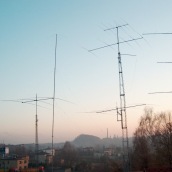
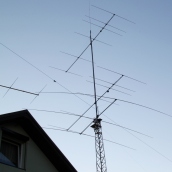 For logging purposes we use WIN-TEST software in a small network of 3 PC`s linked together through a local area network.
For logging purposes we use WIN-TEST software in a small network of 3 PC`s linked together through a local area network.The most recent and important antenna project is to modify the existing low band antennas used for transmit. More complex electronic repairs are made by Jozef SP9HVW who is an expert in that matter.
Since 2012, as new rules for WPX and ARRL MULTI OP categories arrives, we find Multi Two entries more suitable for us. This is because the limitation of band change rules does not promote activity on more than one radio at any given time. As a result we cannot use our stations full potential.
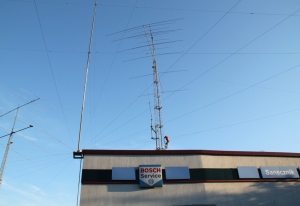
To date our best achievements are: Contest Mode Year Category Place ARRL SSB 2010 MS 5 EU ARRL CW 2010 MS 8 EU RUSSIAN DX MIX 2008 M2 3 W WWDX SSB 2008 MS 15 EU WWDX CW 2008 MS 14 EU WPX CW 2010 MS 13 W 9EU WPX SSB 2010 MS 10 EU WAEDC CW 2010 MS 4 EU WAEDC SSB 2007 MS 4 EU WWDX SSB 2012 M2 18 W 8EU WWDX CW 2012 M2 16 EU
As an addition to the scores listed above, several times we have reached the top position in our domestic contest station competition called INTERCONTEST HF.
Author: Edward SP9H. Editorial: Peter SP9QMP. Translation: Maciek SQ6MS close
The K9CT Contest Station - Craig Thompson K9CT
September 2014
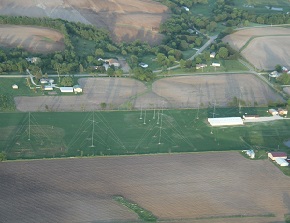 The K9CT Contest Station was created as a project and challenge for myself. The spark that lead to this was the compromises of living in close quarters to my
neighbors and finding out what could be done to get to the next level in contesting. My curiosity of all of the technologies and designs that could be implemented
whet my appetite for the project. But most of all, the camaraderie of the dxpedition team environment lead me to the multi-operator contesting setup.
The K9CT Contest Station was created as a project and challenge for myself. The spark that lead to this was the compromises of living in close quarters to my
neighbors and finding out what could be done to get to the next level in contesting. My curiosity of all of the technologies and designs that could be implemented
whet my appetite for the project. But most of all, the camaraderie of the dxpedition team environment lead me to the multi-operator contesting setup.I wanted a blank canvas to work with and needed some land for the project. My search for property started in 2008 and continued until 2009 when I acquired 18 acres of flat land about four miles from my home and station. I did some research before looking for the land. Contesters were surveyed and responses were gathered. Generally, I was advised to find a flat rectangular plot of about 10 to 20 acres. The long portion of the rectangle needed to run north-south so that the towers would line up and the EU and JA paths would provide isolation between antennas. more
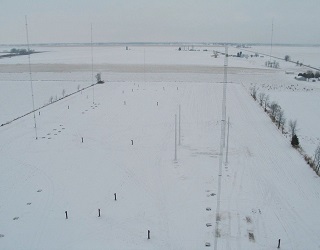 The site was prepared as it had drainage issues, buried tires and buildings in disrepair to be demolished. While this was being completed, I visited several
contesters to learn from them about many aspects of team contesting, station layout and antenna usage. This was a tremendous help. I was perplexed very early as
to the many options for designing and laying out the contest station.
The site was prepared as it had drainage issues, buried tires and buildings in disrepair to be demolished. While this was being completed, I visited several
contesters to learn from them about many aspects of team contesting, station layout and antenna usage. This was a tremendous help. I was perplexed very early as
to the many options for designing and laying out the contest station.I decided that my goals for the project were to be:
- 3 db louder than my home station on all bands
- Station designed around 1.8 to 1296 MHz
- Multi-two, multi-one and single operator two radio class of operation
- Maximize antenna isolation at main population areas
- Multiplier antennas
- Low band receiving antennas
- EME to complete 2M WAS and DXCC
- Station attractive to team members for comfort and enjoyment
 From previous experience with our building permit process, I had contacted the zoning department for our local county and inquired as to the proper zoning to be able
to have the best possible path to building permit. The zoning was for Agriculture and was the most open to any type of structure. However after submission of the
permit request, I met with resistance from the public because the county wanted to go through a hearing process. Shortcutting the story, I secured the services of
K1VR, Fred Hopengarten and we withdrew our original request and resubmitted a request for permit without the hearing process. The legal department for the county
reviewed our application and directed our county building department to issue the permit. We then had one year to complete the 11 tower project.
From previous experience with our building permit process, I had contacted the zoning department for our local county and inquired as to the proper zoning to be able
to have the best possible path to building permit. The zoning was for Agriculture and was the most open to any type of structure. However after submission of the
permit request, I met with resistance from the public because the county wanted to go through a hearing process. Shortcutting the story, I secured the services of
K1VR, Fred Hopengarten and we withdrew our original request and resubmitted a request for permit without the hearing process. The legal department for the county
reviewed our application and directed our county building department to issue the permit. We then had one year to complete the 11 tower project.With the permit in hand, I secured the services of John, W2GD and Don, K4ZA to consult and erect the towers and antennas. A three stack of monoband OWA yagis were selected for 10, 15 and 20 meters, and a two stack for 40 meters. Using HFTA, towers were to be 190 feet for the 40 and 20 meter stacks and 150 feet for the 15 and 10 meter stacks. The towers were rotated with K0XG base rotators and hardware. I chose to use elevated guys for farming the land so the professional engineering services of Hank Lonberg, KR7X were contracted. We worked together to choose the tower locations and he did the calculations for wind loading with ice on the tower and antennas. I chose to put the low band antennas further away from the shack and the higher frequency antennas nearer the station to minimize feed line loss. 1⅝” Heliax was searched and acquired to trench to each tower for a low loss feed line.
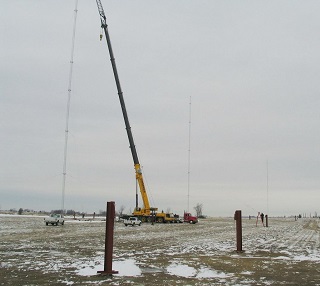 The project commenced right after the PJ7E activation. Most material had been secured and we tackled the project with lots of manpower and machinery. All foundations
were dug and rebar prepared...cement was poured within 7 days! 125 plus cubic yards of concrete was in the ground. The tower was preassembled on the ground shortly
thereafter. The longest pieces were 100 feet and then laid on pallets to keep off the ground. The cement cured for thirty days and we were ready to install the towers.
The project commenced right after the PJ7E activation. Most material had been secured and we tackled the project with lots of manpower and machinery. All foundations
were dug and rebar prepared...cement was poured within 7 days! 125 plus cubic yards of concrete was in the ground. The tower was preassembled on the ground shortly
thereafter. The longest pieces were 100 feet and then laid on pallets to keep off the ground. The cement cured for thirty days and we were ready to install the towers.Cold weather hit hard on the day we wanted to commence the crane work. The crane froze before we could get started! A new crane arrived the next day and within four days we had all towers up and guyed! It was still cold and we even had some snow while doing this work but the crews battled through it and towers glistened in the morning sun upon completion.
Over the winter, antennas were being assembled and fabricated. The VHF antennas were completed the first nice spring day and the EME antennas and frame were carefully assembled for many days in a row. The OWA antennas arrived the day before 2011 Dayton Hamvention. Much work to do after that!
 A large trench was dug from the soon to be built shack to the mult-tower using a backhoe. The rest of the coax was trenched to all of the tower locations. 9400 feet
of 1⅝” was buried along with almost 1900 feet of 1¼”. Power and rotator control cables were also direct buried.
A large trench was dug from the soon to be built shack to the mult-tower using a backhoe. The rest of the coax was trenched to all of the tower locations. 9400 feet
of 1⅝” was buried along with almost 1900 feet of 1¼”. Power and rotator control cables were also direct buried.Many saw horses were secured from the local building supply stores and placed throughout the 18 acres so that the 60 foot boom OWAs could be assembled next to each tower. The crane could then easily move to each tower and then lift the antennas to the tower climbers. All antennas were in place in less than a week’s time using this method. The Stackmatches were mounted at the base of each tower and ½” Heliax were installed to each antenna….carefully wrapping the excess lines on the tower for a nice appearance.
All summer we plowed in thousands of feet of THHN wire at base of the 80m 4 square and the 160m 5 element array. The farmer had prepped the soil at each location so that they were weedless and evenly bared soil. Wherever the radials met, they were silver soldered to a common copper buss wire. Every tower had several ground rods installed and attached to the base with copper buss wire and Cadwelded.
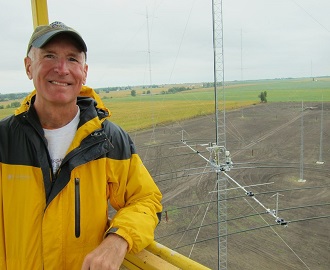 Simultaneous to the activities in the field, a new building was designed and constructed for Multi-two station operation. An open room was provided for the operators
and contesting. Adjacent to that the bathroom with urinal for the quick trips needed in the middle of a contest! A shower and bunk room next to that and more isolated
was a break room with small kitchen and dining area. All of the walls were insulated for noise isolation and a good door to the shack area could be closed for sleeping
or when the conversation was a bit loud in the break area. A garage and workshop were located at the far end of the building.
Simultaneous to the activities in the field, a new building was designed and constructed for Multi-two station operation. An open room was provided for the operators
and contesting. Adjacent to that the bathroom with urinal for the quick trips needed in the middle of a contest! A shower and bunk room next to that and more isolated
was a break room with small kitchen and dining area. All of the walls were insulated for noise isolation and a good door to the shack area could be closed for sleeping
or when the conversation was a bit loud in the break area. A garage and workshop were located at the far end of the building.The building was completed in time for us to setup on tables for the CQ WW Phone as a M/S. Towers were still manually rotated in the field and nothing was automatic in the shack….it was more a Field Day operation but still much fun to try out the antennas in a contest.
Work progressed rapidly following the first contest. Station consoles were designed so that two operators could sit side by side with plenty of room for each to have two flat screen monitors.
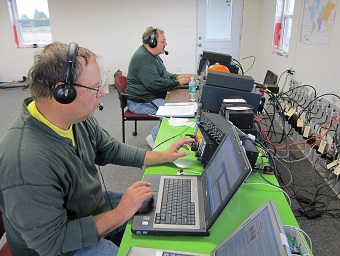 Comfortable chairs were tried over many contests and finally selected for best comfort for long hours of operating. Station was carefully
designed for best operator ergonomics. Eyes on monitors and hands on the keyboard.
Comfortable chairs were tried over many contests and finally selected for best comfort for long hours of operating. Station was carefully
designed for best operator ergonomics. Eyes on monitors and hands on the keyboard.I decided to minimize wiring and get as much done with wireless using Green Heron Everywhere and WiFi network. I setup a server to connect to the rotators, Stackmatches, and Steppir controllers. Each radio position computer was a client to the served devices. Any band change would select the correct antenna, filter and on screen rotator and stackmatch. N1MM uses UDP on the network for band information. Green Heron and PSTRotatorAZ use these packets to make band changes.
Presets were created for the main population areas for contests. Green Heron EK devices are used to rotate the receiving and transmitting antennas for the low bands. Wireless keyboard and mouse are used to eliminate EMI to the computers.
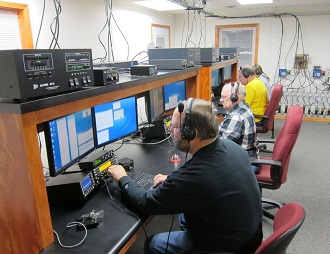 We have three years of contest seasons under our belt now. We have a solid team for our contests with only a few new operators needed to fill in when the regulars
could not play. Refinements have been made to improve ergonomics and some technical issues that have emerged. Lightning has hit a couple of times in the area and
repairs were needed. Learning from these experiences, tweaks to the installation and programming have been implemented.
We have three years of contest seasons under our belt now. We have a solid team for our contests with only a few new operators needed to fill in when the regulars
could not play. Refinements have been made to improve ergonomics and some technical issues that have emerged. Lightning has hit a couple of times in the area and
repairs were needed. Learning from these experiences, tweaks to the installation and programming have been implemented.How has the station played? We have broken most of the W9 or CQ Zone 4 records in our category for CQ WW, WPX and ARRL DX. Our Reverse Beacon Signal reports have been equal or better than our peers. Timing is everything…we have broken the USA WPX record from the Black Hole! (also so did our east coast competition) I have operated the station a few times in domestic contests and found that most of the antennas are too high or narrow in pattern. I have added a few low dipoles and setup a portable to tower to fill the void. My plan is to add a crankup tower with the proper antenna to solve this issue. A 3 element yagi for 80m still awaits the right tower.
This has been a fun project. I now have a ham radio “man cave” to find escape any day I can. My team mates for these big contest weekends enjoy the team spirit and pleasant environment as well as I do. Many clubs and hams have stopped by for the “tour”…visitors from several countries have made stop….some for entire weekends.
This has truly been a great experience for me. It has been fun collaborating with so many contesters to build this station. Contesters have been more than willing to share their “secrets”. This project has been rewarding in so many ways….friendships, competition, and technical challenges. See you on the bands! close
The DF0HQ Contest Station - Ben Bieske DL5ANT
September 2014
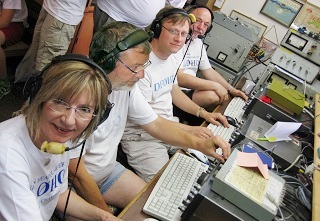 The contest club station DF0HQ is located on a small hill (550m asl.) in Ilmenau, Thuringia, Germany, JO50LQ. The first activity
at this QTH started in 1970 setting up a 3 band cubical quad antenna using the famous call Y34K. This is our favorite antenna type
up to now.
The contest club station DF0HQ is located on a small hill (550m asl.) in Ilmenau, Thuringia, Germany, JO50LQ. The first activity
at this QTH started in 1970 setting up a 3 band cubical quad antenna using the famous call Y34K. This is our favorite antenna type
up to now.Over the years five different quad antennas were designed using EZNEC and covering the bands from 40m to 10m.
For the low bands we use loops, ground planes and Beverages in five directions.
The rigs are mostly Kenwood TS 950 and 850 installed in 6 places for 6 Bands operating at the same time.
Since 2005 we use WinTest contest software as a replacement for CT. more
 The location is well opened at 360 degrees and has a special slope in the valley right towards Stateside.
The location is well opened at 360 degrees and has a special slope in the valley right towards Stateside.The club station is operated by the members of the Ilmenau Contest Club and friends. As DARC members we have the DOK “X34 TU Ilmenau”. The name shows our background of the technical university.
Beside single OP activities we have four main club events during the year:
WAE SSB as DF0HQ MS
WWDX contests SSB and CW as DF0HQ MM
IARU HF World Championship as DA0HQ German headquarters team
(160, 80, 40 SSB and 15 CW)
We have several plaques on the wall showing the long history of contesting and top results.
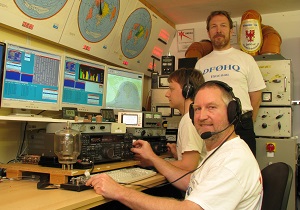 Once a year we invite interested people to see what we are doing and what are the main facts about ham radio. Newcomers and guests
are always welcome.
Once a year we invite interested people to see what we are doing and what are the main facts about ham radio. Newcomers and guests
are always welcome.The landscape from the top of the tower is very impressive: towards North America there is a downhill slope of 400m in a 300m distance with incredible signals from that direction.
There is always much work to do on the antennas after the winter season. The main problem is ice at the wires and glass fiber elements due to ice rain or freezing fog.
More pictures: 1 2 3 4 5 6 7
See you on air in contests or DX-ing. 73 Ben DL5ANT / DF0HQ close
The YT8A Contest Station - Dušan Ćeha YU1EA
September 2014
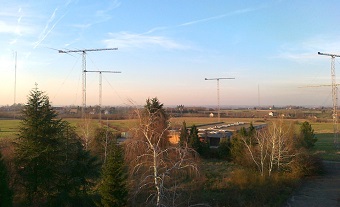 The station is located about 45 km from Belgrade. Me and my friend and neighbour Ivan-YU1LA are using this location only for contesting.
The station is located about 45 km from Belgrade. Me and my friend and neighbour Ivan-YU1LA are using this location only for contesting. There is a field of different kinds of HF antennas such as verticals, log periodics, rombics and some wire antennas: beverage for USA, beverage for Japan, beverage for Brasil (all 380m long).
My favourite category is SOSB 40m HP, sometimes SOAB HP. The most favorable bands are 40m, 80m and 160m but I have the best results on 40m.
My favourite contests are: CQ WW CW/SSB/RTTY, CQ WPX CW/SSB/RTTY, CQ160 CW/SSB, Russian DX Contest, IARU Contest, EU HF Contest, ARRL CW/SSB. more
The set up is: Kenwood TS-590+TS-2000, OM-2500+SB-220, M-box (SO-2R). Software: N1MM, Win test and Mixwin.
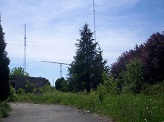
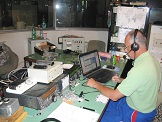
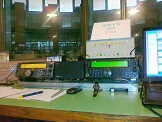


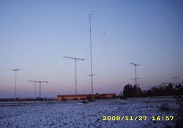
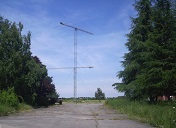

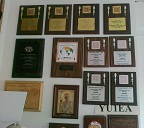
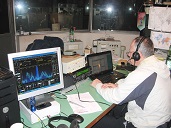
73 Dušan Ćeha YU1EA/ YT8A close
The LY2W Gang - Sam Zalnerauskas LY5W
August 2014
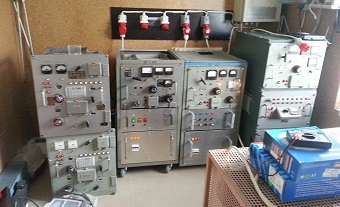 LY2W is the personal callsign of Arturas Snipas (ex-UP2BGF, LY2GF). You can find this call on all bands during the major contests of the year: CQ WW DX Contest,
CQ WW WPX Contest.
LY2W is the personal callsign of Arturas Snipas (ex-UP2BGF, LY2GF). You can find this call on all bands during the major contests of the year: CQ WW DX Contest,
CQ WW WPX Contest.For these contests a Multi-Operator team is usually organized, mostly in the Multi-Two category. The quantity of operators varies from 5 to 12, depending on people available.
At present we have verticals for 160 and 80 meter bands, 3 element full size Yagi about 30 meters up. For the 20 meter band we have a 5 element monobander about 20m high. For 15 meters a 6 element monobander is put on a 20m high tower. The antenna for the 10 meter band is in the design process, temporarily a 5 element Yagi is used at a modest height. more
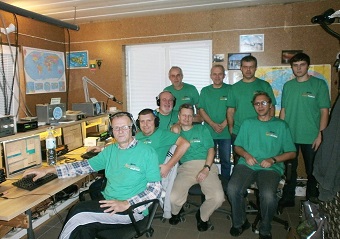 All Power Amplfiers are homemade, basically they are constructed from surplus Red Army military equipment.
All Power Amplfiers are homemade, basically they are constructed from surplus Red Army military equipment.Usually we use 3 Kenwood TS-590s, the software used is N1MM or Wintest.
Today LY2W is holder of the following records for Lithuania:
CQWW SSB Multi-Two 2012 8,577,219 points CQWW SSB Multi-Two 2013 14,238,840 points CQWPX SSB Multi-Two 2012 10,941,016 points CQWPX CW Multi-Two 2012 10,200,288 points
More pictures: 1 2
73, Sam LY5W one of the LY2W gang. close






